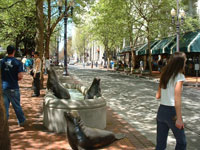
www.pedbikeimages.org by Andy Hamilton
Intuitively it makes sense that creating more walkable communities will help meet the 2008 Physical Activity Guidelines from Americans because walking is the most frequent form of Physical activity. I wondered whether walkability makes a difference and which communities have tackled this issue. I got curious about this and did a search to find out more.
My first stop was to look into whether community design makes a difference in increasing physical activity rates. I visited The Community Guide for Preventive Services Web site where I learned that their research confirmed the increase in community members’ physical activity levels after land use policies are put into place at the community level and even at the street level!
I also noticed that progress is being made towards meeting the Healthy People 2010 objective to increase the proportion of trips made by walking. For adults, the objective was to increase from the baseline of 17% in 1995 to 25 percent. As of 2001, this measure had increased to 21%.
How timely! Just when my curiosity was aroused, a colleague told me about the Pedestrian and Bicycle Information Center’s new recognition program, Walk Friendly Communities with applications opening November first.
Even more fascinating, the PBIC has a search tool that you can use to find examples of policies and changes implemented in cities across the country to improve walkability. Their Pedestrian and Bicycle Information Center also Case Study Compendium includes dozens of examples of communities with pedestrian and bicycle projects and programs. Planning pedestrian programs ranged from the City of Charlotte North Carolina’s Commitment to the Pedestrian Program to a Traffic Calming Guidelines project in Sacramento, California.
My next stop was to visit the CDC’s Healthy Places Web page and browse the recent CDC community design report issued in April that illustrated the importance of taking public health, including physical activity, into account when creating the built environment. The report included five case studies of communities that illustrate best practices in community design to support good health. One of these communities, Lakewood, Colorado, is paying particular attention to walkability as it develops the Belmar Project, a pedestrian centered residential and retail area.
In this same report, Bill Gilchrist, a member of the American Institute of Architects, working with Miami-Dade County, briefed participants in this expert workshop on his urban design work with them. He commented that when the environment is healthier, there is a more economically thriving community. Interestingly, Gilchrist noted the University of Wisconsin-Madison’s Center for Community Economic Development report The Economic Benefit of a Walkable Community that highlighted several economic benefits of a more walkable community and ways to make communities more walkable.
Last summer, HHS hosted a Webinar on June 15th for Physical Activity Guidelines Supporters. As part of the Webinar Nicole Rioles, Campaign Coordinator discussed Shape Up Somerville, a Massachusetts citywide campaign to increase daily physical activity and healthy eating. The campaign includes a number of interventions including walkability and safe routes to schools.
Now, I’m even more curious to learn from you. What is your community doing to build a healthy community that is more walkable?